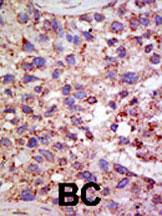USP11 Antibody (N-term N20)
Purified Rabbit Polyclonal Antibody (Pab)
- 产品详情
- 实验流程
- 背景知识
Application
| WB, IHC-P, E |
|---|---|
| Primary Accession | P51784 |
| Other Accession | NP_004642 |
| Reactivity | Human |
| Host | Rabbit |
| Clonality | Polyclonal |
| Isotype | Rabbit IgG |
| Calculated MW | 109817 Da |
| Antigen Region | 279-308 aa |
| Other Names | Ubiquitin carboxyl-terminal hydrolase 11, Deubiquitinating enzyme 11, Ubiquitin thioesterase 11, Ubiquitin-specific-processing protease 11, USP11, UHX1 |
|---|---|
| Target/Specificity | This USP11 antibody is generated from rabbits immunized with a KLH conjugated synthetic peptide between 279-308 amino acids from the N-terminal region of human USP11. |
| Dilution | WB~~1:1000 IHC-P~~1:100~500 E~~Use at an assay dependent concentration. |
| Format | Purified polyclonal antibody supplied in PBS with 0.09% (W/V) sodium azide. This antibody is prepared by Saturated Ammonium Sulfate (SAS) precipitation followed by dialysis against PBS. |
| Storage | Maintain refrigerated at 2-8°C for up to 2 weeks. For long term storage store at -20°C in small aliquots to prevent freeze-thaw cycles. |
| Precautions | USP11 Antibody (N-term N20) is for research use only and not for use in diagnostic or therapeutic procedures. |
| Name | USP11 |
|---|---|
| Synonyms | UHX1 |
| Function | Protease that can remove conjugated ubiquitin from target proteins and polyubiquitin chains (PubMed:12084015, PubMed:15314155, PubMed:17897950, PubMed:19874889, PubMed:20233726, PubMed:24724799, PubMed:28992046). Inhibits the degradation of target proteins by the proteasome (PubMed:12084015). Cleaves preferentially 'Lys-6' and 'Lys- 63'-linked ubiquitin chains. Has lower activity with 'Lys-11' and 'Lys- 33'-linked ubiquitin chains, and extremely low activity with 'Lys-27', 'Lys-29' and 'Lys-48'-linked ubiquitin chains (in vitro) (PubMed:24724799). Plays a role in the regulation of pathways leading to NF-kappa-B activation (PubMed:17897950, PubMed:19874889). Plays a role in the regulation of DNA repair after double-stranded DNA breaks (PubMed:15314155, PubMed:20233726). Acts as a chromatin regulator via its association with the Polycomb group (PcG) multiprotein PRC1-like complex; may act by deubiquitinating components of the PRC1-like complex (PubMed:20601937). Promotes cell proliferation by deubiquitinating phosphorylated E2F1 (PubMed:28992046). |
| Cellular Location | Nucleus. Cytoplasm. Chromosome. Note=Predominantly nuclear (PubMed:12084015, PubMed:15314155). Associates with chromatin (PubMed:20233726, PubMed:20601937). |
For Research Use Only. Not For Use In Diagnostic Procedures.
Provided below are standard protocols that you may find useful for product applications.
BACKGROUND
Modification of target proteins by ubiquitin participates in a wide array of biological functions. Proteins destined for degradation or processing via the 26 S proteasome are coupled to multiple copies of ubiquitin. However, attachment of ubiquitin or ubiquitin-related molecules may also result in changes in subcellular distribution or modification of protein activity. An additional level of ubiquitin regulation, deubiquitination, is catalyzed by proteases called deubiquitinating enzymes, which fall into four distinct families. Ubiquitin C-terminal hydrolases, ubiquitin-specific processing proteases (USPs),1 OTU-domain ubiquitin-aldehyde-binding proteins, and Jab1/Pad1/MPN-domain-containing metallo-enzymes. Among these four families, USPs represent the most widespread and represented deubiquitinating enzymes across evolution. USPs tend to release ubiquitin from a conjugated protein. They display similar catalytic domains containing conserved Cys and His boxes but divergent N-terminal and occasionally C-terminal extensions, which are thought to function in substrate recognition, subcellular localization, and protein-protein interactions.
REFERENCES
Strausberg, R.L., et al., Proc. Natl. Acad. Sci. U.S.A. 99(26):16899-16903 (2002).
Swanson, D.A., et al., Hum. Mol. Genet. 5(4):533-538 (1996).
Ideguchi, H., et al., Biochem. J. 367 (Pt 1), 87-95 (2002).
终于等到您。ABCEPTA(百远生物)抗体产品。
点击下方“我要评价 ”按钮提交您的反馈信息,您的反馈和评价是我们最宝贵的财富之一,
我们将在1-3个工作日内处理您的反馈信息。
如有疑问,联系:0512-88856768 tech-china@abcepta.com.























 癌症的基本特征包括细胞增殖、血管生成、迁移、凋亡逃避机制和细胞永生等。找到癌症发生过程中这些通路的关键标记物和对应的抗体用于检测至关重要。
癌症的基本特征包括细胞增殖、血管生成、迁移、凋亡逃避机制和细胞永生等。找到癌症发生过程中这些通路的关键标记物和对应的抗体用于检测至关重要。 为您推荐一个泛素化位点预测神器——泛素化分析工具,可以为您的蛋白的泛素化位点作出预测和评分。
为您推荐一个泛素化位点预测神器——泛素化分析工具,可以为您的蛋白的泛素化位点作出预测和评分。 细胞自噬受体图形绘图工具为你的蛋白的细胞受体结合位点作出预测和评分,识别结合到自噬通路中的蛋白是非常重要的,便于让我们理解自噬在正常生理、病理过程中的作用,如发育、细胞分化、神经退化性疾病、压力条件下、感染和癌症。
细胞自噬受体图形绘图工具为你的蛋白的细胞受体结合位点作出预测和评分,识别结合到自噬通路中的蛋白是非常重要的,便于让我们理解自噬在正常生理、病理过程中的作用,如发育、细胞分化、神经退化性疾病、压力条件下、感染和癌症。







